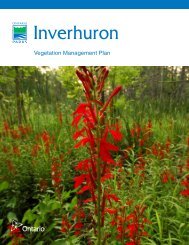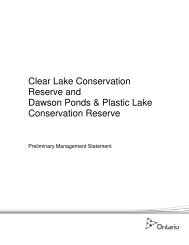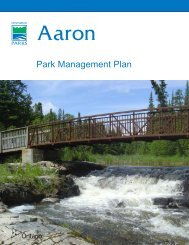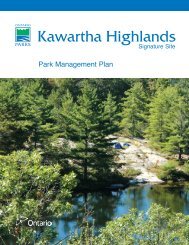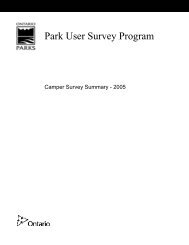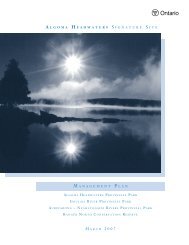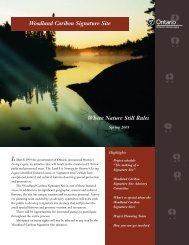Vegetation Plan - Ontario Parks
Vegetation Plan - Ontario Parks
Vegetation Plan - Ontario Parks
Create successful ePaper yourself
Turn your PDF publications into a flip-book with our unique Google optimized e-Paper software.
APPENDIX 6: Invasive <strong>Plan</strong>ts at Inverhuron Provincial Park<br />
Adapted from (Havinga et al. 2000) and (Johnson and Parker 1975)<br />
Scientific Name Common Name Effect on Natural Area<br />
Category 1 – Species that exclude all other species and dominate sites indefinitely. They may be difficult to<br />
control and tend to disperse widely.<br />
Alliaria petiolata Garlic Mustard Dominates forest herb layer<br />
Cirsium arvense Canada Thistle Dominates meadows, prairies and forest edges<br />
Phragmites australis Common Reed Dominates wetlands and wet meadows<br />
Rhamnus cathartica Common<br />
Dominates forest understory, meadows and prairies<br />
Buckthorn<br />
Category 2 – Species that are highly invasive and tend to dominate certain niches.<br />
Melilotus alba White Sweet Clover Dominates meadows and prairies<br />
Populus alba<br />
European White Invades meadows<br />
Poplar<br />
Vinca minor Periwinkle Dominates forest understory<br />
Galium mollugo Wild Madder Invades meadows<br />
Category 3 – Moderately invasive, but can become locally dominant.<br />
Dactylis glomerata Orchard Grass Invades meadows and prairies<br />
Salix alba White Willow Invades wetlands, displaces native Salix spp.<br />
Salix fragilis Crack Willow Invades wetlands, displaces native Salix spp.<br />
Ranunculus repens Creeping Buttercup Invades meadows<br />
Berberis vulgaris Common Barberry Invades forests<br />
Barbarea vulgaris Yellow Rocket Invades meadows<br />
(Winter Cress)<br />
Euphorbia cyparissias Cypress Spurge Invades meadows<br />
Pastinaca sativa Wild Parsnip Invades meadows<br />
Convolvulus arvensis Field Bindweed Dominates meadows<br />
Solanum dulcamara Bittersweet Invades forests and wetlands<br />
Nightshade<br />
Carduus nutans Nodding Thistle Invades meadows and prairies<br />
Centaurea jacea Brown Knapweed Invades meadows and prairies<br />
Hieracium aurantiacum Orange Hawkweed Invades meadows<br />
Onopordum acanthium Scotch Thistle Invades meadows and disturbed open areas<br />
Category 4 – Can compete with native vegetation and become difficult to eradicate.<br />
Bromus inermis<br />
Smooth Brome Resists conversion to native meadow and prairie<br />
Grass<br />
Lolium perenne<br />
Perennial Rye Competes with prairie species<br />
Grass<br />
Setaria spp Foxtail grasses Invade prairies<br />
Salix purpurea Purple Osier Willow Invades wetlands, displaces native Salix spp.<br />
Rumex acetosella Sheep Sorrel Invades Meadows<br />
Euphorbia esula Leafy Spurge Can dominate prairies<br />
Hypericum perforatum Common St. Johns Can dominate meadows<br />
Wort<br />
Nepeta cataria Catnip Invades meadows<br />
Mentha Xpiperita Peppermint Invades meadows<br />
Linaria vulgaris Butter and Eggs Invades meadows<br />
Campanula<br />
Creeping Bellflower Invades forest edges and meadows<br />
rapunculoides<br />
Tussilago farfara Coltsfoot Invades wet meadows and riverbanks<br />
Potentially Invasive Species to Monitor<br />
Daphne mezereum Mezer’s Daphne Has invaded moist forests in S. <strong>Ontario</strong><br />
Verbascum thapsus Common Mullein Invades meadows and open forests<br />
36





